
“If any man wishes to be humbled and mortified, let him become President of Harvard College,” Harvard President Edward Holyoke was quoted as saying. A tombstone with the name Holyoke is in the cemetery.
Stephanie Mitchell/Harvard Staff Photographer
Amid the Old Burying Ground
Resting place of Harvard presidents and paupers alike, this cemetery has centuries of tales to tell
Cambridge’s settlement-era Old Burying Ground is filled with the bones — and perhaps the spirits — of dead presidents, professors, and people from all walks of life. The cemetery is inexorably intertwined with the early years of Harvard College, or, in the language of 1636, the Colledge at Newtowne.
Over the centuries, the cemetery became the final resting place for some of the most important and recognizable figures in Harvard’s early history: Henry Dunster, John Leverett, Benjamin Wadsworth, Edward Holyoke, Edward Wigglesworth, and Nathaniel Appleton. Other family names — Allston, Brattle, Craigie, Davis, Hancock, Porter, and Tufts — are familiar today not only as historical figures but as monikers that eventually came to adorn iconic locations and institutions in and around modern Cambridge, Somerville, and Boston.
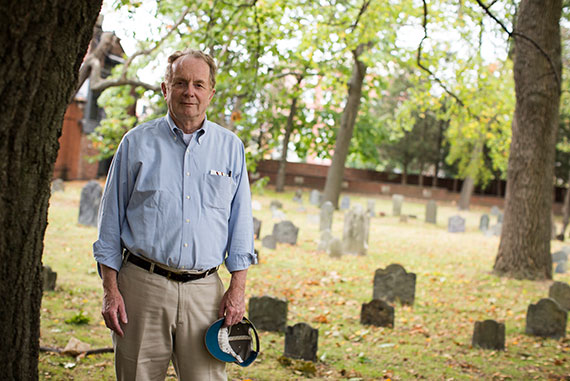
The Old Burying Ground was opened in 1636 at the edge of Cambridge Common. Located at the intersection of today’s Massachusetts Avenue and Garden Street, it received its first residents only five years after the establishment of Newtowne, which was renamed Cambridge in 1638. For nearly 200 years, it interred the settlement’s dead.
By the early 1800s, the cemetery ceased to accept regular burials, with the general exception of descendants of those already interred. Today, many of the 1,218 known graves are still visible among the grass, trees, and shrubs that dot the two-acre site, their weathered headstones tilting toward the sky. But it is likely that hundreds more were buried there, since spaces were continuously reused during the colonial era.
Each day, hundreds of Harvard faculty and students stroll past the Old Burying Ground, unaware of its significance.
1630s Cambridge
Colonial Newtowne took root and blossomed on the edge of European settlement, bordered on one side by the Charles River — a source of safety, supplies, and transportation — and on the other three by untamed country. A mere 10 years separated the arrival of the Mayflower passengers at Plymouth and the founding of Cambridge.
“It was a wilderness,” said Charles Sullivan, executive director of the Cambridge Historical Commission for the past four decades, as well as a 1970 graduate of the Harvard Graduate School of Design. “This was the frontier.”
Though the surrounding region was wild, the new residents quickly began to arrange the land they controlled to serve different functions, from housing and agriculture to burials.
What was to become Harvard Yard was, famously, then only one part of a large cow pasture that stretched from today’s Cambridge Common west and south until it met the river.

“The center of the village was where Winthrop Park is,” Sullivan said, referring to the swath of grass and trees, flanked on one side by Peet’s Coffee and Grendel’s Den, where JFK and Mount Auburn streets intersect. “There was never a lot of crop agriculture here. It was mostly cattle. That’s why the Yard is the Yard: It was a cow yard.”
“Anyone who has seen stockyards can imagine what Harvard Yard looked (and smelt) like before the College was founded,” wrote the most important chronicler of its early history, Harvard Professor Samuel Eliot Morison, in his 1935 volume “The Founding of Harvard College.” Morison’s research is the basis of much of what is now known about that era of Harvard’s history. In 2009, then-Hollis Professor of Divinity Harvey Cox recalled Cambridge’s bovine beginnings by taking up his legendary right to graze a cow on Harvard Yard.
Watch-house Hill — from which early residents kept an eye out for fires and other dangers to the fledgling community — stood near the site of today’s Lehman Hall, across from the primary entrance to the MBTA and Out of Town News. A small creek trickled out of the Yard near today’s replica water pump and flowed down toward the river. The Charles River estuary was much wider than it is today, with most of the area south of today’s Malkin Athletic Center — including the river Houses and Memorial Drive — just tidal marshland. Today’s Dunster Street was then known as Water Street, and dead-ended at a ferry landing where villagers could cross to Boston.
In 1635, Harvard College consisted of one building, a house previously owned by William Peyntree, situated in the middle of modern Massachusetts Avenue (then Braintree Street), just outside Holyoke Gate. Its subterranean foundations were discovered by workers extending the MBTA’s Red Line. To the north, east, and west of Harvard Yard was wilderness. While most Indians had either fled or died of European diseases, Sullivan said, early residents still had to contend with the untamed areas around them.
Establishing a place to bury the dead was an early priority for the settlers.
“You’re going to have to deal with people who die, which was a real significant part of life at that time in a much more prominent way than we think of it,” said Stephen Shoemaker, lecturer on the study of religion at the Harvard Divinity School.
As ancient as it is, the Old Burying Ground is actually Cambridge’s second cemetery.
“The first cemetery was outside the original village — along today’s Brattle Street, near Longfellow Park — but it was being disturbed by wolves so they moved it here about five years after settlement,” Sullivan said. No trace has been found.
The new cemetery was just inside the Common Pales, a fence or barrier that separated the town from the wilderness beyond.
“The theory was that wolves wouldn’t cross a man-made boundary, no matter how notional or marginal it was,” Sullivan said, describing the barrier as perhaps a ditch or stacks of brush. “I don’t think that’s true, but they thought it was.”
A working cemetery was of particular importance to the new College.
“Early on it was thought that ‘we need a place to put the students who die while they are here term-time,’ because smallpox would come through and large numbers of people would disappear during an epidemic,” said Shoemaker.
The first currently identifiable grave is that of Ann Erinton, who died in 1653 at age 77, nearly two decades after the first burials occurred. By then, however, it is likely that scores of early colonists had been interred there. Indeed, records include the names of approximately 100 Cambridge residents who died between 1638 and 1653, most of whom presumably would have been laid to rest in the Old Burying Ground.
“They weren’t putting up stone markers until the very beginning [of the] 18th century,” Sullivan noted. “Once stone slabs became commonplace, we think some of the earliest markers were [from] descendants who erected stones to their ancestors, which is why we have stones dated from earlier years.”
The stones often carried the telltale memento mori, images of death designed to remind the living of their own mortality.
“The Puritans were trying to frighten people with images of death,” Sullivan said. “Even when you’re alive, you’re close to death. Here is death staring you in the face. So, straighten up and fly right.”
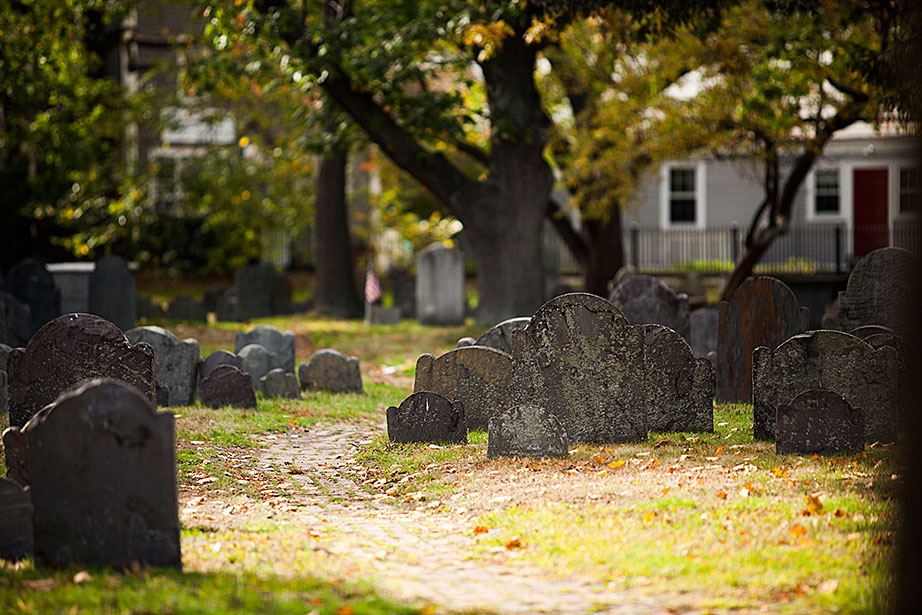
The presidents and professors
The tombs of seven presidents of Harvard College — including three of the first four — are still visible in the Old Burying Ground. Their graves are adjacent to the First Parish Church, and to the backs of such Church Street operations as the Christian Science Reading Room and the pizza restaurant Cambridge, 1.
“Most of the Harvard presidents rest in the main body of the cemetery,” said Sullivan. “There is a plot that Harvard owns and maintains. It was established because Harvard students and some faculty were dying far from home and transportation was difficult. They wanted a sure place to have them buried here.”
Henry Dunster was both Harvard’s first president and the first to be buried in Cambridge. Born in England, he was invited to lead the fledging institution after its first master, Nathaniel Eaton, was dismissed for allegedly mistreating students.
“After the abuses of Nathanial Eaton, Harvard actually closed for a year,” said Shoemaker. “They reopened the doors to Harvard with Dunster in charge.”
It was Dunster who truly established the College, erecting its first building near modern Grays Hall and securing in 1650 the charter that still governs the University.
“He really saved the institution,” Shoemaker said.
Dunster also owned the triangular lot at the intersection of modern JFK and Elliot streets, currently occupied by the Curious George Store, over which an inscription in the window advertises the legal services of Dewey, Cheetham, & Howe (say it out loud to get the joke), the fictional firm made famous by NPR’s “Car Talk” brothers, Tom and Ray Magliozzi.
But like Eaton, Dunster eventually left Harvard under a cloud after he refused to have his infant son baptized, believing that the practice was only appropriate for adults. After falling out with Massachusetts’ Puritan (and pro-infant baptism) leaders, and annoyed by what he considered inordinate levels of interference by the Board of Overseers, he resigned in 1654 and was replaced by Charles Chauncy, who founded the Indian College and who was eventually interred within feet of his predecessor.
Today, a nondescript gray table tomb marks the supposed location of Dunster’s remains. The inscriptions on the top of the stone face have worn away, but a freshly placed metal plaque on one side declares: HENRY DUNSTER 1609-1659 FIRST PRESIDENT OF HARVARD COLLEGE 1640-1654 IN CHRISTI GLORIUM.
The location was identified in the 19th century, when antiquarians opened several tombs and “decided that one skeleton wrapped in a tarpaulin in a coffin stuffed with tansy (an aromatic native plant used to conceal the smell of decomposition) was Dunster’s and ordered a monument for him. John Langdon Sibley, who recorded the exhumations in his ‘Private Journal,’ was skeptical,” Susan Maycock and Charles Sullivan note in “Building Old Cambridge: Architecture and Development.”
In addition to Dunster and Chauncy, the tombs of Harvard Presidents Urian Oakes, John Leverett, Benjamin Wadsworth, Joseph Willard, and Edward Holyoke can be found nearby.
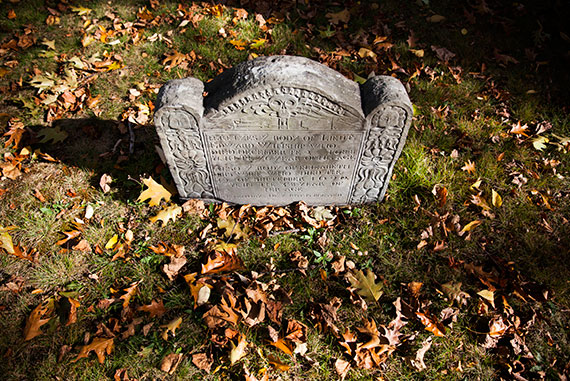
Harvard’s first secular president, Leverett oversaw the establishment of the first endowed chair and the construction of Massachusetts Hall, the University’s oldest existing building. Wadsworth, the College’s eighth president, is principally remembered today as the first resident of the House that bears his name, which served as the president’s residence for more than a century and now houses faculty and administrative offices.
After nearly 32 years in office, Holyoke — after whom Holyoke Gate, Holyoke Street, and, formerly, Holyoke Center (now the Richard A. and Susan F. Smith Campus Center) were named — famously said: “If any man wishes to be humbled and mortified, let him become President of Harvard College.”
Presidents’ families
Despite the presence of these luminaries, the Old Burying Ground was at the time the only known repository for Cantabrigians’ remains. As in most cemeteries, Harvard’s presidents and other community leaders were surrounded by the remains of their family members, either in individual graves or in subterranean family vaults.
“A lot of these table tombs conceal a flight of steps and a vault underground,” Sullivan explained. “Inside, there are shelves on either side” where the remains were placed.
Unlike epitaphs on the presidents’ tombs, which were uniformly inscribed in Latin, their relatives and other commoners often settled for English. A poem carved onto the grave of Chauncy’s wife, Catherine, ended with a warning to future generations of Harvard students, faculty, and staff.
Pale ghastly death hath sent his shaft
And hath by Chance nigh broke our heart
Deaths volleys sound, sad stormes appeare,
Morning draws on: Poore Harverd feare,
Least this sad stroke should be a signe
Of suddeine future death to thine.
On their deaths, prominent faculty members joined presidents and commoners in the Old Burying Ground. Wigglesworth, the first holder of the oldest endowed chair in the United States, the Hollis Professor of Divinity, was interred near the remains of his daughter Sibeyll and his second wife, Rebecca, both of whom predeceased him. His second daughter, Mary, was buried alongside them in 1758. His first son, also named Edward, became the second holder of the prestigious chair, recently held by Cox and now held by Karen Leigh King.
Broken gravestones, lost epitaphs
Regular interments in the Old Burying Ground ceased in 1811, when a new cemetery was established in Cambridgeport. By the mid-19th century, the Burying Ground had become a relic. Many gravestones had disappeared, and many others had been rendered illegible by the ravages of time, neglect, and vandalism.
Much of the site’s history would have been lost but for the efforts of William Thaddeus Harris, a graduate of Harvard College with an interest in local history. Harris, a virtual paraplegic due to a curvature in his spine, according to Sullivan, decided to record for posterity every epitaph before they too disappeared. His book, “Epitaphs from the Old Burying-Ground in Cambridge, With Notes,” published in 1845, includes information about scores of gravestones whose inscriptions have since gone missing or become unreadable.
Harris noted how the cemetery had fallen into disrepair.
“It is rather surprising, that, in this age of improvement, Cambridge should fall behind her neighbours, and suffer her ancient grave-yard to lie neglected,” he wrote. “Many of the tombs are without the names of the owners; many of the grave-stones have been broken, and more are broken every year; brambles abound instead of shrubbery; and what might be a beautiful cemetery is converted into a common passage-way.
“Unfitting is it, indeed, that the sod beneath which rest the ashes of a Shepard, a Dunster, and a Michel, should be rioted over by every vagrant schoolboy,” he wrote, presumably referring to Harvard undergraduates.
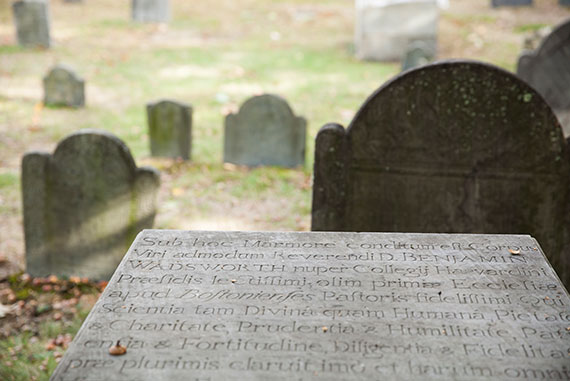
African-Americans in colonial Cambridge
The Old Burying Ground also serves as reminder that despite the anti-slavery attitudes of many (but not all) of their 19th-century descendants, people in 17th-century Massachusetts were deeply involved with the enslavement of Africans. Presidents such as Increase Mather and Wadsworth are known to have owned slaves. It is in Wadsworth’s house, today situated next to Holyoke Gate along Massachusetts Avenue, where his several slaves likely lived and worked.
It is also likely that slavery existed at the College’s outset, according to the study “Harvard and Slavery: Seeking a Forgotten History” authored by Laird Bell Professor of History Sven Beckert, Katherine Stevens, and the students of the Harvard and Slavery Research Seminar.
“In 1639 the wife of Harvard’s first schoolmaster, Nathaniel Eaton, confessed to a committee that her husband had mismanaged the college,” they write. “Among the offenses of his tenure was the time a person she called ‘the Moor’ slept in student Samuel Hough’s ‘sheet and pillow-bier.’ She also admitted that students complained about having to eat the same food as ‘the Moor.’ Drawn from the Spanish name for North Africans, ‘Moor’ was a common term for African slaves.”
Enslaved men and women played key roles in the early years of Cambridge and Harvard. “In daily, uncountable, and often unnoticed ways, these slaves supported life and learning on Harvard’s campus,” they conclude.
Two headstones in the Old Burying Ground testify to the presence of enslaved women. The first, a small slate stone, curved at the top and adorned with a skull and wings, reads: “Here lyes the body of Cicely, Negro, late Servant to the Reverend Minister William Brattle; she died April 8. 1714. Being 15 years old.”
Brattle was a 1680 graduate of the College who, alongside the future President Leverett, took an active teaching and leadership role at Harvard while then-President Mather was in England for several years. Today’s Brattle House, Brattle Street, and Brattleboro, Vt., are named for his son, General William Brattle.
By contrast, we know nothing of Cicely’s young life, other than what we can assume. The Rev. Brattle died in 1717 and, like Cicely, was laid to rest in the Old Burying Ground. Unequal in life, they achieved equality in death.
A similar gravestone reads: “Jane a Negro Servant. to Andrew Bordman Esquire Died 1740/1 Aged 22 years & 3 Months.”
The Bordmans had long and deep connections to Harvard and Cambridge. Two adult Andrew Bordmans were alive in 1740. Andrew Bordman II (1670-1747) served as Harvard steward from 1703 to 1747. Much like today’s Office of Student Life, the steward managed residential operations, purchasing supplies, and supervising staff. His son, Andrew Bordman III (1701-1769), graduated from the College in 1719 and also served as Harvard steward from 1747 to 1750. Both were prominent members of the community, each serving as town clerk and town treasurer.
Cicely and Jane’s graves are solid evidence that slavery existed, and even thrived among the highest echelons of Cambridge society, until after the American Revolution. Harvard’s connections to slavery weren’t fully severed until the American Civil War.
A precarious existence
Life in the 17th century, particularly amid frontier conditions, was precarious. Graveyard epitaphs speak to the lives and deaths of hundreds of Cambridge residents, old and young. But perhaps the most moving today are those dedicated to children.
Indeed, child mortality — like death generally — was heartbreakingly commonplace in colonial Cambridge, even among the families of Harvard’s presidents and faculty, who would have had access to the best nutrition and medical care available.
“Childhood mortality was a significant component of family life,” Shoemaker said. “You would assume that only a percentage of the family was going to survive, and it wasn’t anything close to 100 percent.”
The family of John Leverett represents but one example: “Here lyes inter’d two infant children of the Reverend Minister John & Mrs. Margaret Leverett. John Leverett, born 21st June and Died the 4th of July Anno Dom. 1711. Anne Leverett Born 5th July, and Died the 30th. of the same month Anno Dom. 1708.”
The deaths in their infancy of these two children came only years after that of their older sister Margaret, who died in 1702. Leverett’s fourth child, also named Margaret, died in 1716. All were interred in the cemetery. Two daughters who survived him — Sarah Leverett Wigglesworth and Mary Leverett Rogers — are buried nearby. A tablet marking the resting place of his wife, Margaret, daughter of Harvard’s fifth president, John Rogers, can still be seen today on the side of Leverett’s tomb.
The Puritans altered their theological approach to death to make it possible to believe that children who died young could be saved. According to Shoemaker, in order to become a full member of the church and thereby gain entry to heaven, an individual needed to have conversion experience. Children, especially infants, lacked that opportunity, and were therefore threatened with eternal damnation.
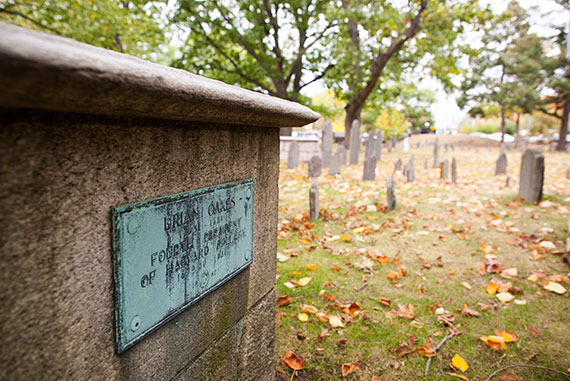
“They couldn’t have a theological system that was telling these people that your child was burning in hell. They designed a formula to allow grace to extend to those who hadn’t reached that point,” said Shoemaker.
Noting that New England’s population grew rapidly during and after the period, Joyce Chaplin, the James Duncan Phillips Professor of Early American History, cautioned that the rate of childhood deaths, or even deaths among settlers generally, should be considered in context.
“New England would become famous for its rapid rate of increase. In the settler population, births vastly outnumber deaths,” Chaplin said. “This is in contrast to the steep decline of native American populations. Indian graveyards are not as carefully memorialized, which gives a misleading sense of who matters historically.”
The last two centuries
For the Old Burying Ground, the last two centuries represented a slow retreat from relevance. As Mount Auburn Cemetery became the third burial site in Cambridge, new interments slowed. Among the last were 19 bodies identified as Revolutionary War soldiers — including two slaves — who had died fighting the British at the Battle of Bunker Hill. The Cambridge Common had been a staging area for militiamen who had traveled to Boston from across the region after the first shots were fired at Lexington and Concord. Much larger at the time, the Common was ideal for a makeshift army camp.
Buried in haste, the soldiers’ graves remained unmarked until Eben Horsford, baking powder magnate and Rumford Professor and Lecturer on the Application of Science to the Useful Arts, decided to locate them.
“He dug … up some remains that he imagined without any real evidence must have been Minutemen,” Sullivan recounted. “That’s why the monument was placed in that section of the cemetery.”
The grass above the graves was often tended by sheep, as grazing rights were regularly bid out in exchange for pay or services.
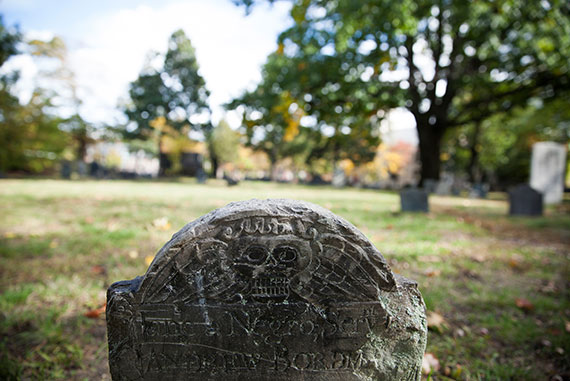
In the 1930s, a commission including Morison and Harvard President James Conant re-landscaped the Old Burying Ground, rescuing it from oblivion and giving it its current appearance. The work was funded by Depression-era federal grants designed to create jobs and lift the economy.
The last known burials in the cemetery were of the Rev. Samuel McChord Crothers in 1927 and, more than half a century later, Gardiner Day, the minister of Christ Church. Day’s marker can be seen underfoot just inside the gate that leads to Christ Church.
While disused as a cemetery, the Old Burying Ground still gets new — or returning — additions from time to time.
“People will call us up and say: ‘I have this friend who has this gravestone. He doesn’t know why he has it. But he wants to give it back to you.’” Sullivan said, referring to the Cambridge Historical Commission. “Not him, of course. His friend,” he added with a wry smile. “It’s one of the weird things about living in a college town. People get crazy and want to take a souvenir.”




